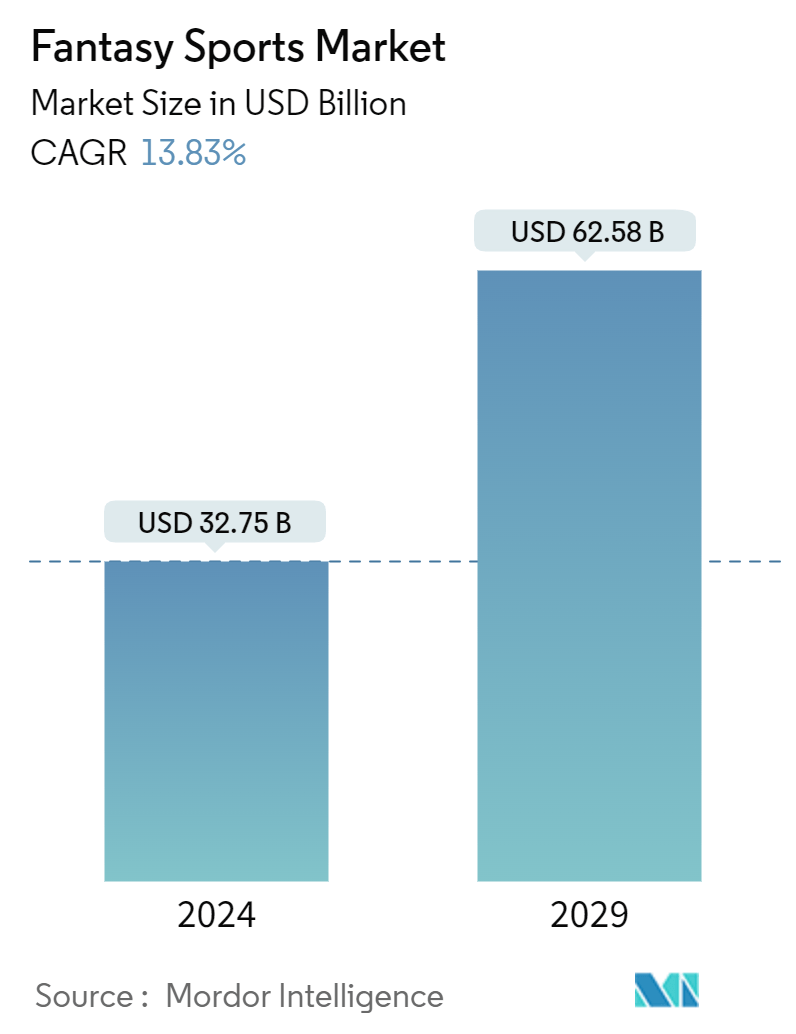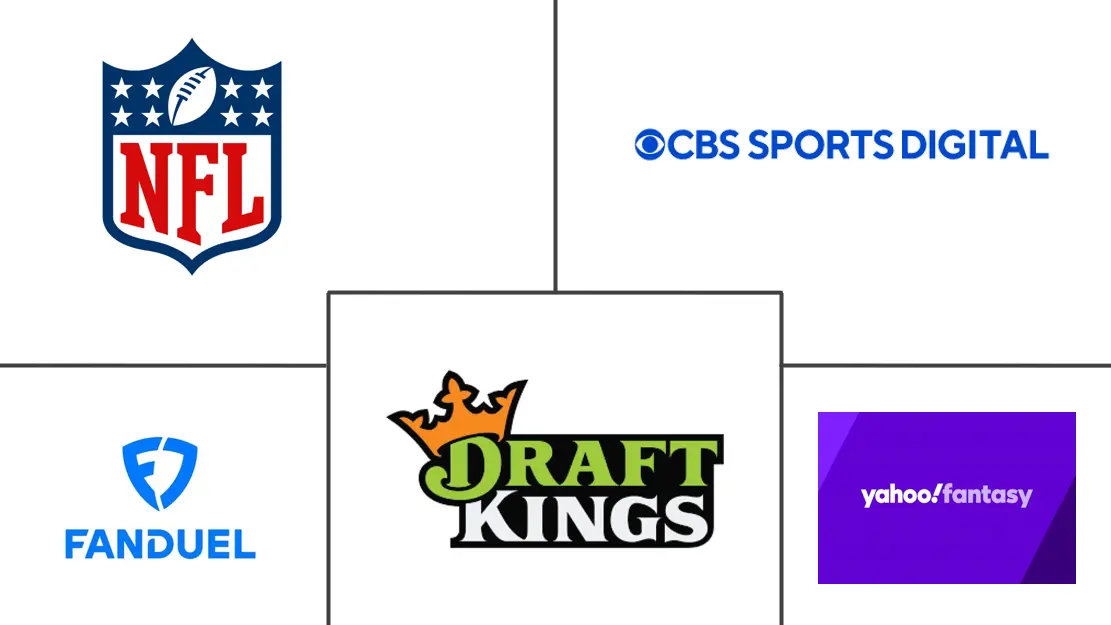Market Size of Fantasy Sports Industry

| Study Period | 2019 - 2029 |
| Market Size (2024) | USD 32.75 Billion |
| Market Size (2029) | USD 62.58 Billion |
| CAGR (2024 - 2029) | 13.83 % |
| Fastest Growing Market | Asia Pacific |
| Largest Market | North America |
Major Players
*Disclaimer: Major Players sorted in no particular order |
Fantasy Sports Market Analysis
The Fantasy Sports Market size is estimated at USD 32.75 billion in 2024, and is expected to reach USD 62.58 billion by 2029, growing at a CAGR of 13.83% during the forecast period (2024-2029).
Fantasy sports have become a prominent social phenomenon. The sport's increasing importance at an elite level attracts large investors, fantasy players, and fans alike. From draft parties to brand marketing and sponsorships to playoffs, fantasy sports engage fans with the competition.
A shift in the sporting culture has occurred over recent years with the introduction of several sports leagues, including badminton, football, rugby, basketball, and volleyball. In different countries, the growth of sports has been accelerated by technological progress, increasing use of smartphones, and internet penetration. With an increasing number of individuals participating in, discussing, or playing these sports, an enthusiastic fan base has developed, shaping how fans engage in sports and fueling the growth of fantasy sports.
Sports technology will create opportunities for highly qualified software engineers, data scientists, and cybersecurity professionals. It will likely increase the number of viewers, sponsors, and participation in sporting events, directly impacting sports development.
The growing popularity of players, the emergence of sports leagues, increasing investments in digital and internet infrastructure, and the launch of fantasy football applications to connect with their favorite sporting activity are driving the market growth.
More users should be encouraged to participate in fantasy sports due to awareness about their legality. In parallel, fantasy sports operators are beginning to actively market their products and make a conscious effort to ensure the integrity of their websites or applications by cooperating with professional football leagues.
Despite the problems caused by the COVID-19 pandemic in some fantasy leagues, these leagues continued to operate despite the shortened professional season. Despite the pandemic, the long-term prospects for fantasy sports are anticipated to remain positive. Due to increased interest in legalizing sports betting in the United States, the market has been experiencing a major influx of new players and well-financed new start-ups.
Fantasy Sports Industry Segmentation
Fantasy sports are online games where participants create virtual teams of real-life professional athletes. The market defines the revenue from the sales of fantasy sports platforms and services.
The fantasy sports market is segmented by type (football, baseball, cricket, basketball, and car racing), platform (website and mobile application), demographics (under 25 years, between 25 and 40 years, and above 40 years), application (individual competition and team competition), and geography (North America, Europe, Asia-Pacific, and Rest of the World). The market sizes and forecasts are provided in terms of value (USD) for all the above segments.
| By Type | |
| Football | |
| Baseball | |
| Cricket | |
| Basketball | |
| Car Racing | |
| Other Types |
| By Platform | |
| Website | |
| Mobile Application |
| By Demographics | |
| Under 25 Years | |
| Between 25 and 40 Years | |
| Above 40 Years |
| By Application | |
| Individual Competition | |
| Team Competition |
| By Geography*** | |
| North America | |
| Europe | |
| Asia | |
| Australia and New Zealand | |
| Latin America | |
| Middle East and Africa |
Fantasy Sports Market Size Summary
The fantasy sports market is experiencing significant growth, driven by the increasing popularity of sports leagues and the integration of technology in sports engagement. This market has evolved into a major social phenomenon, attracting substantial investments and a dedicated fan base. The rise of smartphones and internet accessibility has facilitated the expansion of fantasy sports, allowing more individuals to participate and engage with their favorite sports. The market is further bolstered by the development of sports technology, which creates opportunities for professionals in software engineering, data science, and cybersecurity. Despite challenges such as legal barriers in certain regions, the market's long-term prospects remain positive, with ongoing efforts to enhance the integrity and appeal of fantasy sports platforms.
In North America, the fantasy sports market, particularly in football, is robust and poised for substantial growth due to increased demand and technological advancements. The market is characterized by a fragmented landscape where companies like CBS Sports Digital, DraftKings Inc., and FanDuel Group leverage strategic partnerships and innovations to expand their market share. The convenience of online betting through connected devices is a key driver of market expansion. Additionally, international interest in markets like Canada is growing, fueled by technological innovation and changing consumer preferences. As the market continues to evolve, companies are focusing on strategic collaborations and product innovations to capture new opportunities and enhance profitability.
Fantasy Sports Market Size - Table of Contents
-
1. MARKET INSIGHTS
-
1.1 Market Overview
-
1.2 Industry Value Chain Analysis
-
1.3 Industry Attractiveness - Porter's Five Forces Analysis
-
1.3.1 Bargaining Power of Suppliers
-
1.3.2 Bargaining Power of Buyers
-
1.3.3 Threat of New Entrants
-
1.3.4 Threat of Substitute Products
-
1.3.5 Intensity of Competitive Rivalry
-
-
1.4 Assessment of Impact of COVID-19 on the Market
-
-
2. MARKET SEGMENTATION
-
2.1 By Type
-
2.1.1 Football
-
2.1.2 Baseball
-
2.1.3 Cricket
-
2.1.4 Basketball
-
2.1.5 Car Racing
-
2.1.6 Other Types
-
-
2.2 By Platform
-
2.2.1 Website
-
2.2.2 Mobile Application
-
-
2.3 By Demographics
-
2.3.1 Under 25 Years
-
2.3.2 Between 25 and 40 Years
-
2.3.3 Above 40 Years
-
-
2.4 By Application
-
2.4.1 Individual Competition
-
2.4.2 Team Competition
-
-
2.5 By Geography***
-
2.5.1 North America
-
2.5.2 Europe
-
2.5.3 Asia
-
2.5.4 Australia and New Zealand
-
2.5.5 Latin America
-
2.5.6 Middle East and Africa
-
-
Fantasy Sports Market Size FAQs
How big is the Fantasy Sports Market?
The Fantasy Sports Market size is expected to reach USD 32.75 billion in 2024 and grow at a CAGR of 13.83% to reach USD 62.58 billion by 2029.
What is the current Fantasy Sports Market size?
In 2024, the Fantasy Sports Market size is expected to reach USD 32.75 billion.

